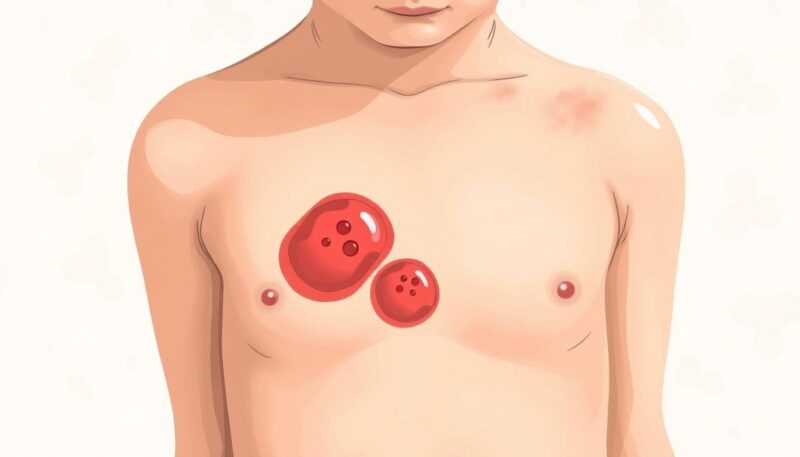Understanding shingles in children is essential for every parent. While this viral infection, medically known as herpes zoster, is more frequently associated with adults, it can also affect children, particularly those who have previously experienced chickenpox. The varicella-zoster virus (VZV) lies dormant in the body after a child recovers from chickenpox and can reactivate later. This reactivation may be more likely in kids with weakened immune systems. As a responsible guardian, it’s crucial to recognize the symptoms of pediatric shingles and know when to seek medical help. With children who have received the chickenpox vaccine being 78% less likely to develop shingles, awareness of their vaccination status can make a substantial difference. Most pediatric cases of shingles are mild but can lead to complications if not addressed promptly. Remaining informed about the potential risks and symptoms can help ensure your child’s health and well-being are safeguarded.
Understanding Shingles in Children
Shingles, medically known as herpes zoster, can affect children despite its higher prevalence in adults. The condition arises primarily from the reactivation of the varicella-zoster virus, which lies dormant in nerve cells after a childhood varicella-zoster infection. Understanding the shingles causes can help in recognizing and addressing this health concern effectively.
What Causes Shingles?
Several factors determine the likelihood of a child developing shingles. Notably, if a child contracts chickenpox before the age of 1, the risk for pediatric shingles increases significantly. Maternal chickenpox during late pregnancy can further elevate this risk, particularly in the newborn. Children with compromised immune systems, such as those undergoing cancer treatment, also face a heightened danger of encountering shingles.
The Role of Chickenpox
Having a previous chickenpox infection directly contributes to the risk of shingles later in life. While chickenpox vaccination helps reduce the incidence of shingles, some vaccinated children may still develop symptoms. Generally, such cases tend to bring milder manifestations compared to those who had chickenpox in their youth. Understanding how childhood varicella-zoster plays a central role can aid in lowering the chances of shingles affecting your child.
Recognizing Symptoms and Diagnosis of Shingles in Children
Understanding how to identify shingles symptoms in kids is crucial for early intervention and effective treatment. Early signs are often similar to other common ailments but can lead to more serious issues. Observing and acting on these symptoms promptly can help mitigate discomfort for your child.
Common Symptoms of Pediatric Shingles
Initially, shingles symptoms kids experience may include:
- Localized pain or burning sensations in a specific area
- Tingling or itching, usually developing before a rash appears
- A rash that starts as small red spots and progresses to blisters
- Fever and chills
- Headaches and nausea
The rash typically heals within 10 to 14 days, although it may take longer for full recovery. Understanding these symptoms is important, especially since the shingles rash in children is generally less painful than in adults.
How is Shingles Diagnosed?
The process of diagnosis primarily involves a physical examination. A healthcare provider will assess the rash and inquire about reported symptoms. In some cases, laboratory tests may be necessary to confirm the presence of the virus. Recognizing the symptoms early on contributes to effective management and treatment.
Shingles vs. Chickenpox
It is essential to distinguish between shingles and chickenpox, as both conditions originate from the varicella-zoster virus but present differently:
| Feature | Shingles | Chickenpox |
|---|---|---|
| Age of Onset | More common in adults and older children | Predominantly affects younger children |
| Rash Appearance | Localized cluster of blisters | Widespread rash across the body |
| Pain Level | Often more painful and may include burning sensations | Usually itchy, but less painful |
| Complications | Can include postherpetic neuralgia | Can lead to infection or complications, particularly in infants |

Conclusion
In summary, shingles in children, while infrequent compared to adults, introduces various challenges that merit prompt attention. The potential symptoms can range from mild discomfort to intense pain, and although shingles complications are rare, they can include significant issues such as postherpetic neuralgia and serious skin infections. It is crucial for you to recognize early signs of shingles, especially when the rash appears on the face or near the eyes, where complications may develop more readily.
Shingles treatment for kids typically revolves around alleviating pain and encouraging healing, often using medications like acyclovir. You should be proactive about your child’s health and know when to see a doctor, as immediate medical intervention can help limit the severity and duration of the condition. Maintaining vigilance in monitoring your child’s symptoms and seeking timely medical advice plays a vital role in ensuring their well-being during this challenging episode.
Overall, being informed about shingles can empower you to take decisive action and support your child’s recovery, minimizing the impact of this viral infection. Remember, early detection and adequate treatment are key in navigating this health concern effectively.

